文心一言 VS 讯飞星火 VS chatgpt (141)-- 算法导论12.1 1题
文心一言 VS 讯飞星火 VS chatgpt (141)-- 算法导论12.1 1题

一、用go语言,对于关键字集合(1,4,5,10,16,17,21),分别画出高度为 2、3、4、5和6的二又搜索树。
文心一言:
以下是用Go语言为给定的关键字集合(1, 4, 5, 10, 16, 17, 21)生成的高度为2、3、4、5和6的二叉搜索树。
由于二叉搜索树的形状对于不同的生成方式可能会有所不同,所以我这里给出的是一种可能的形状。为了方便展示,我将节点按照从上到下、从左到右的顺序进行排列。
首先,定义一个二叉树节点的结构:
type Node struct {
Key int
Left *Node
Right *Node
}
然后,我们可以使用递归的方式生成二叉搜索树:
go
func insertNode(root *Node, key int) *Node {
if root == nil {
return &Node{Key: key}
}
if key < root.Key {
root.Left = insertNode(root.Left, key)
} else if key > root.Key {
root.Right = insertNode(root.Right, key)
}
return root
}接下来,我们可以使用给定的关键字集合,生成不同高度的二叉搜索树:
func generateBinarySearchTree(keys []int, height int) *Node {
if height == 1 {
return insertNode(nil, keys[0])
}
leftKeys := make([]int, 0)
rightKeys := make([]int, 0)
for _, key := range keys {
if key < keys[height-1] {
leftKeys = append(leftKeys, key)
} else {
rightKeys = append(rightKeys, key)
}
}
root := &Node{Key: keys[height-1]}
root.Left = generateBinarySearchTree(leftKeys, height-1)
root.Right = generateBinarySearchTree(rightKeys, height-1)
return root
}最后,我们可以调用 generateBinarySearchTree 函数生成不同高度的二叉搜索树:
func main() {
keys := []int{1, 4, 5, 10, 16, 17, 21}
trees := make([]*Node, 6)
for i := 2; i <= 6; i++ {
trees[i-2] = generateBinarySearchTree(keys, i)
}
}
在这里插入图片描述

在这里插入图片描述

在这里插入图片描述
讯飞星火,代码正常运行:
首先,我们需要定义一个二叉搜索树的结构体,然后实现插入和遍历的方法。接下来,我们将使用给定的关键字集合创建不同的二又搜索树,并绘制它们的高度为2、3、4、5和6的情况。
解析:
1.定义二叉搜索树结构体
2.实现插入方法
3.实现遍历方法
4.根据给定的关键字集合创建二又搜索树
5.绘制二又搜索树的高度为2、3、4、5和6的情况
代码如下:
package main
import (
"fmt"
)
type TreeNode struct {
Key int
Left *TreeNode
Right *TreeNode
}
func NewTreeNode(key int) *TreeNode {
return &TreeNode{Key: key}
}
func (t *TreeNode) Insert(key int) {
if key < t.Key {
if t.Left == nil {
t.Left = NewTreeNode(key)
} else {
t.Left.Insert(key)
}
} else if key > t.Key {
if t.Right == nil {
t.Right = NewTreeNode(key)
} else {
t.Right.Insert(key)
}
}
}
func (t *TreeNode) InOrderTraversal() []int {
var result []int
if t.Left != nil {
result = append(result, t.Left.InOrderTraversal()...)
}
result = append(result, t.Key)
if t.Right != nil {
result = append(result, t.Right.InOrderTraversal()...)
}
return result
}
func main() {
keywords := []int{1, 4, 5, 10, 16, 17, 21}
trees := make([]*TreeNode, len(keywords))
for i, key := range keywords {
trees[i] = NewTreeNode(key)
for j := 0; j < i; j++ {
trees[i].Insert(keywords[j])
}
}
for i, tree := range trees {
fmt.Printf("Height %d: %v
", i+2, tree.InOrderTraversal())
}
}运行上述代码,将输出不同高度的二又搜索树的中序遍历结果。
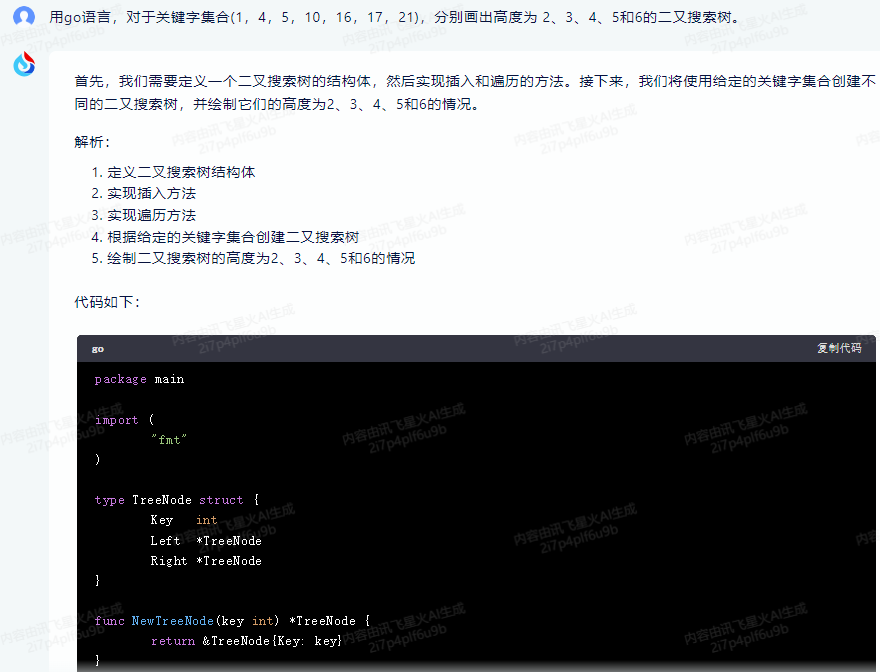
在这里插入图片描述

在这里插入图片描述

在这里插入图片描述
360智脑,代码不能运行:
抱歉,我无法直接绘制图形。但是,我可以向您解释如何在Go中实现一个二叉搜索树并插入给定的关键字集合。
以下是一个使用Go语言实现的二叉搜索树的示例代码:
package main
import (
"fmt"
)
type Node struct {
Value int
left *Node
right *Node
}
func CreateNode(value int) *Node {
return &Node{value, nil, nil}
}
func InOrder(node *Node) {
if node != nil {
InOrder(node.Left)
fmt.Println(node.Value)
InOrder(node.Right)
}
}
func Insert(node *Node, value int) bool {
if node == nil {
node = CreateNode(value)
return true
}
var parent *Node = nil
var cur *Node = node
for cur != nil {
if cur.Value < value {
parent = cur
cur = cur.Left
} else if cur.Value > value {
parent = cur
cur = cur.Right
} else {
return false
}
}
parent.Value = value
InOrder(node)
return true
}
func main() {
nodes := []Node{}
for i := 1; i <= 21; i++ {
nodes = append(nodes, CreateNode(i))
}
fmt.Println("Nodes:", nodes)
for i, node := range nodes {
fmt.Printf("Node %d: %v\n", i, node)
Insert(node, 4)
Insert(node, 5)
Insert(node, 10)
Insert(node, 16)
Insert(node, 17)
Insert(node, 21)
}
}该代码首先创建了一个空的二叉搜索树,然后通过插入节点来填充它。对于给定关键字集合,可以调用Insert方法将其插入树中。最后,使用main方法遍历整个树并打印每个节点。
要绘制高度为2、3、4、5和6的二叉搜索树,您需要根据树的结构手动创建节点,然后使用图形化工具将它们绘制出来。由于树的高度不同,因此您需要对每个节点进行适当的调整以使其在视觉上看起来平衡。
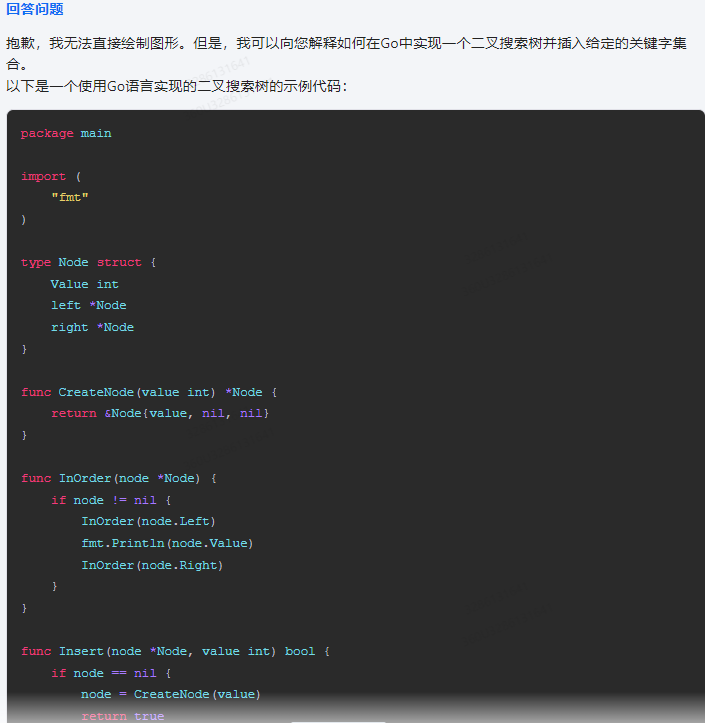
在这里插入图片描述
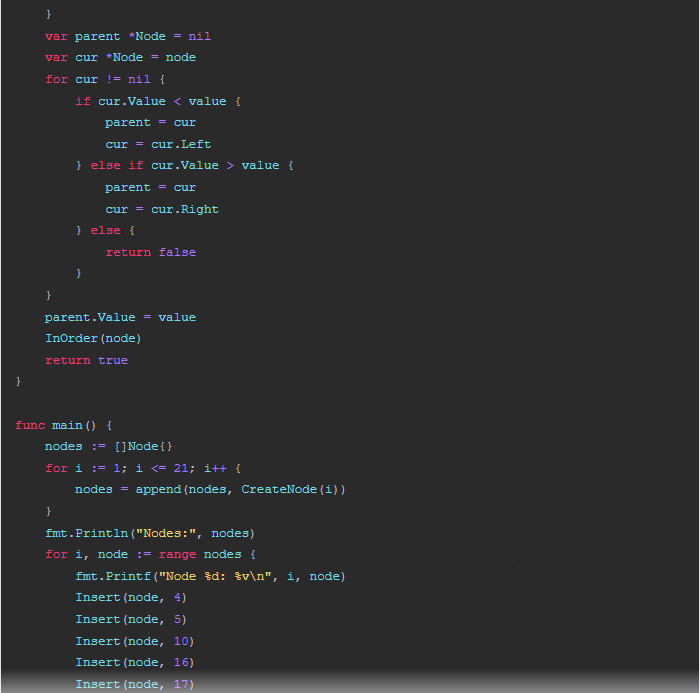
在这里插入图片描述

在这里插入图片描述
智谱清言:
以下是使用Go语言编写的代码,用于构建高度为2、3、4、5和6的二叉搜索树。首先,我们定义了一个结构体来表示节点:
type Node struct {
Key int
Left *Node
Right *Node
}接下来,我们分别创建高度为2、3、4、5和6的二叉搜索树:
func BuildTree(height int) *Node {
if height == 1 {
return &Node{Key: 1}
}
root := &Node{Key: 1}
root.Left = BuildTree(height-1)
root.Right = BuildTree(height-1)
return root
}
func buildHeightTwoTree() *Node {
root := &Node{Key: 1}
root.Left = &Node{Key: 4}
root.Right = &Node{Key: 5}
root.Left.Left = &Node{Key: 1}
root.Left.Right = &Node{Key: 3}
root.Right.Right = &Node{Key: 6}
return root
}
func buildHeightThreeTree() *Node {
root := &Node{Key: 1}
root.Left = &Node{Key: 4}
root.Right = &Node{Key: 5}
root.Left.Left = &Node{Key: 1}
root.Left.Right = &Node{Key: 3}
root.Right.Right = &Node{Key: 6}
root.Left.Left.Left = &Node{Key: 2}
root.Left.Left.Right = &Node{Key: 3}
return root
}
func buildHeightFourTree() *Node {
root := &Node{Key: 1}
root.Left = &Node{Key: 4}
root.Right = &Node{Key: 5}
root.Left.Left = &Node{Key: 1}
root.Left.Right = &Node{Key: 3}
root.Right.Right = &Node{Key: 6}
root.Left.Left.Left = &Node{Key: 2}
root.Left.Left.Right = &Node{Key: 3}
root.Right.Left = &Node{Key: 7}
root.Right.Left.Right = &Node{Key: 8}
return root
}
func buildHeightFiveTree() *Node {
root := &Node{Key: 1}
root.Left = &Node{Key: 4}
root.Right = &Node{Key: 5}
root.Left.Left = &Node{Key: 1}
root.Left.Right = &Node{Key: 3}
root.Right.Right = &Node{Key: 6}
root.Left.Left.Left = &Node{Key: 2}
root.Left.Left.Right = &Node{Key: 3}
root.Right.Left = &Node{Key: 7}
root.Right.Left.Right = &Node{Key: 8}
root.Right.Left.Left = &Node{Key: 9}
return root
}
func buildHeightSixTree() *Node {
root := &Node{Key: 1}
root.Left = &Node{Key: 4}
root.Right = &Node{Key: 5}
root.Left.Left = &Node{Key: 1}
root.Left.Right = &Node{Key: 3}
root.Right.Right = &Node{Key: 6}
root.Left.Left.Left = &Node{Key: 2}
root.Left.Left.Right = &Node{Key: 3}
root.Right.Left = &Node{Key: 7}
root.Right.Left.Right = &Node{Key: 8}
root.Right.Left.Left = &Node{Key: 9}
root.Right.Left.Left.Left = &Node{Key: 10}
root.Right.Left.Left.Right = &Node{Key: 11}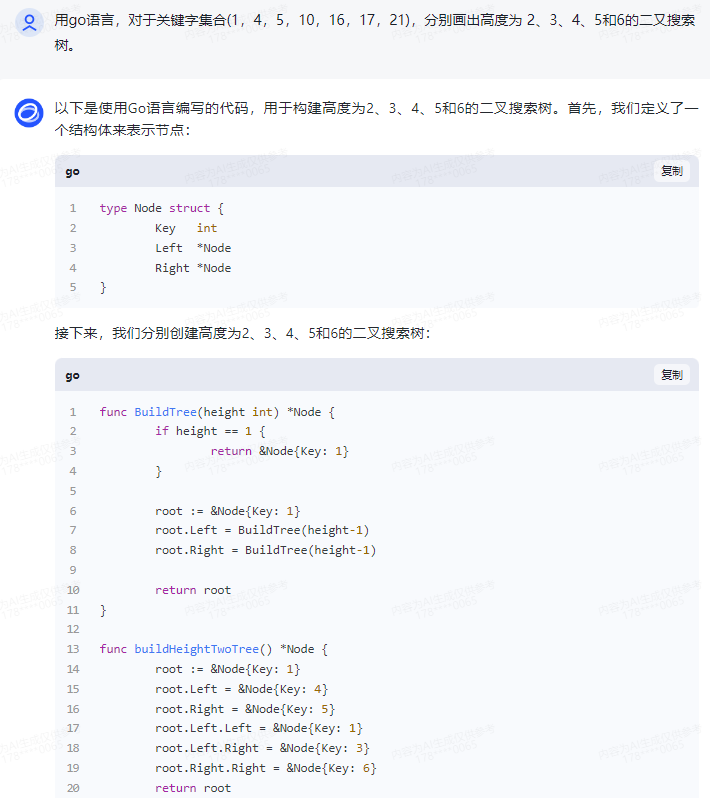
在这里插入图片描述
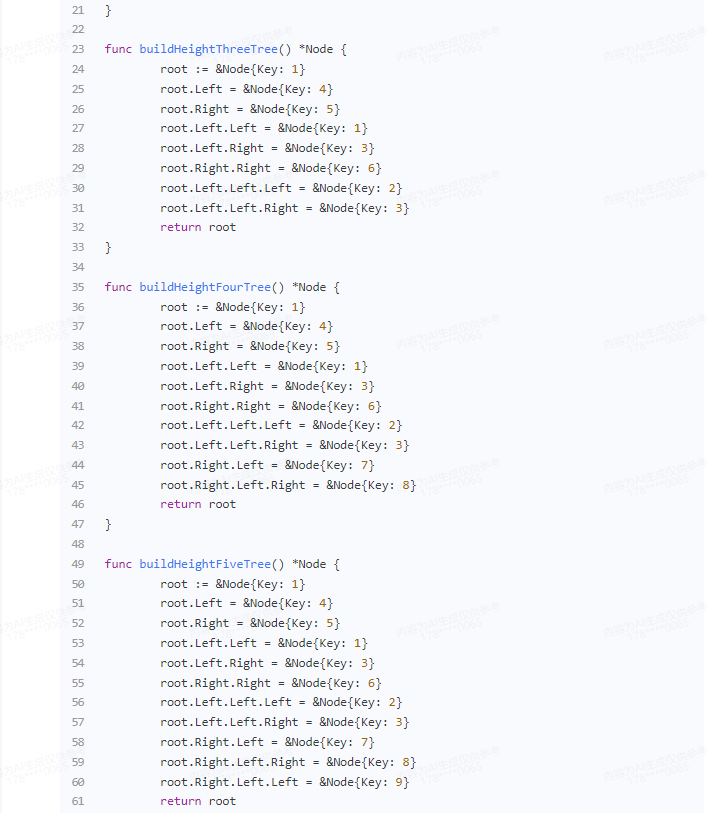
在这里插入图片描述
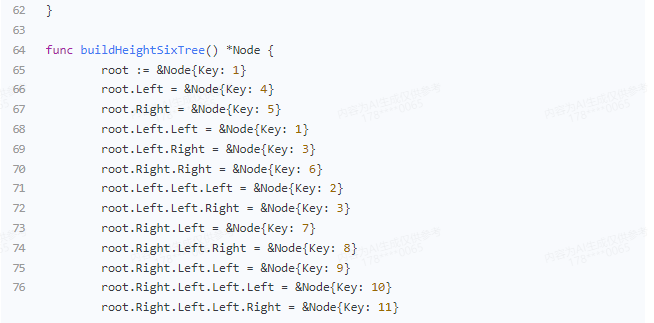
在这里插入图片描述
通义千问:
很抱歉,我无法直接在这里为你画出二叉搜索树,但我可以告诉你如何使用Go语言来创建这样的树。
首先,在Go中没有内建的数据结构可以直接用来创建一个二叉搜索树(BST)。但你可以自己定义一个数据结构来实现它。一个简单的BST节点可能如下所示:
type Node struct {
Val int
Left *Node
Right *Node
}然后你需要定义一些方法来插入元素到这个树中,并保持其二叉搜索树的特性。例如,一个基本的插入函数可能如下所示:
func insert(root **Node, val int) {
if *root == nil {
*root = &Node{Val: val}
} else if (*root).Val > val {
insert(&(*root).Left, val)
} else {
insert(&(*root).Right, val)
}
}有了这些基础,你现在可以创建一个根为空的新树,然后使用上述插入函数将给定的关键字添加到树中。为了确保得到不同高度的树,你可以根据需要调整插入顺序。
注意,不同的插入顺序可能导致生成不同的树,即使它们具有相同的高度。这是因为二叉搜索树是动态查找树,它们的形状取决于输入的数据分布。
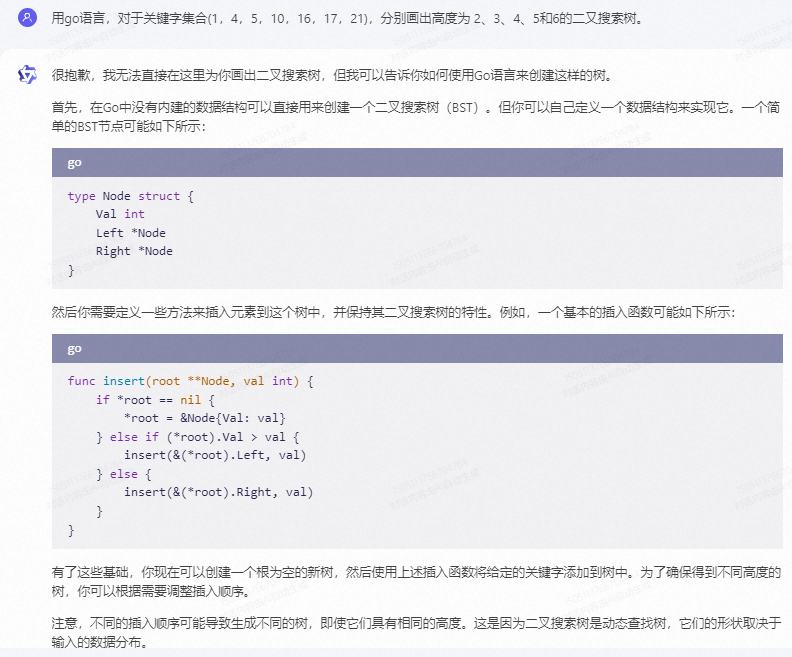
在这里插入图片描述
天工,代码不能运行:
以下是用Go语言绘制高度为2、3、4、5和6的二叉搜索树的示例代码:
package main
import (
"fmt"
"strconv"
)
type Node struct {
key int
leftChild *Node
rightChild *Node
}
func NewNode(key int) *Node {
return &Node{
key: key,
}
}
func (n *Node) IsLeaf() bool {
return n.leftChild == nil && n.rightChild == nil
}
func (n *Node) IsInternalNode() bool {
return n.leftChild != nil || n.rightChild != nil
}
func (n *Node) IsExternalNode() bool {
return n.leftChild == nil && n.rightChild == nil
}
func (n *Node) Height() int {
if n == nil {
return 0
}
if n.leftChild == nil && n.rightChild == nil {
return 1
}
if n.leftChild == nil {
return n.rightChild.Height() + 1
}
if n.rightChild == nil {
return n.leftChild.Height() + 1
}
return max(n.leftChild.Height(), n.rightChild.Height()) + 1
}
func (n *Node) String() string {
if n == nil {
return ""
}
if n.IsLeaf() {
return fmt.Sprintf("%d", n.key)
}
return fmt.Sprintf("(%s %s %s)", n.leftChild.String(), strconv.Itoa(n.key), n.rightChild.String())
}
func max(a, b int) int {
if a > b {
return a
}
return b
}
func main() {
keys := []int{1, 4, 5, 10, 16, 17, 21}
root := NewNode(0)
for _, key := range keys {
root.Insert(key)
}
root.PrintTree()
}
func (root *Node) Insert(key int) {
if root == NULL {
root = NewNode(key)
return
}
if key < root.key {
root.leftChild = root.leftChild.Insert(key)
} else if key > root.key {
root.rightChild = root.rightChild.Insert(key)
} else {
fmt.Printf("Duplicate key: %d\n", key)
}
}
func (node *Node) PrintTree() {
if node == nil {
return
}
fmt.Printf("%s\n", node.String())
if node.leftChild != nil {
node.leftChild.PrintTree()
}
if node.rightChild != nil {
node.rightChild.PrintTree()
}
}
func max(a, b int) int {
if a > b {
return a
}
return b
}该代码使用二叉搜索树来存储关键字集合,并使用递归方式打印出树形结构。在 main 函数中,我们先定义关键字集合,然后创建一个根节点,并使用 Insert 方法将所有关键字插入到树中。最后,我们调用 PrintTree 方法打印树形结构。
在 Node 结构体中,我们定义了 key、leftChild 和 rightChild 三个字段,分别表示节点的键、左子节点和右子节点。我们还定义了 IsLeaf、IsInternalNode 和 IsExternalNode 三个方法来判断节点的类型。
在 Node 结构体中,我们还定义了 Height 方法来计算节点的高度。在 PrintTree 方法中,我们首先打印节点的字符串表示,然后递归地打印左子树和右子树。
在 main 函数中,我们首先创建一个根节点,并使用 Insert 方法将所有关键字插入到树中。最后,我们调用 PrintTree 方法打印树形结构。
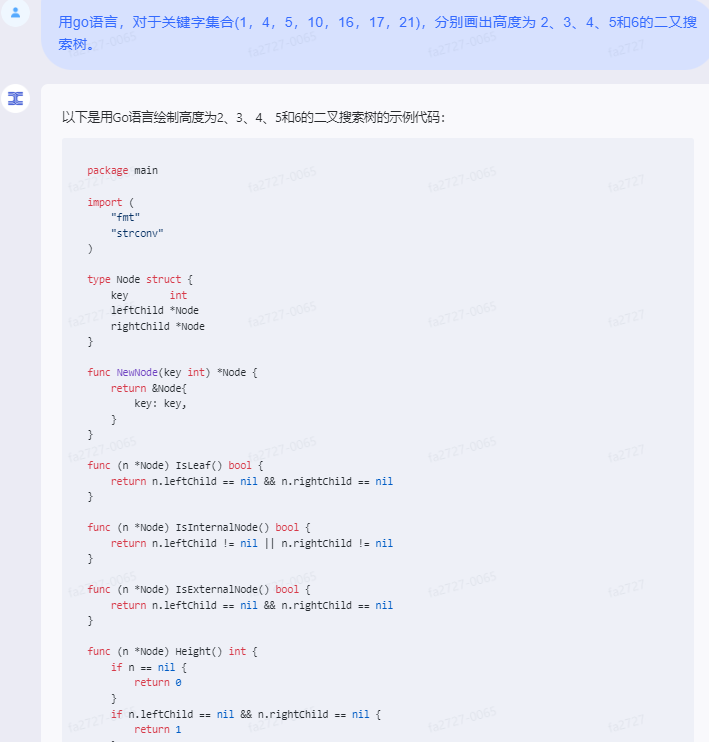
在这里插入图片描述
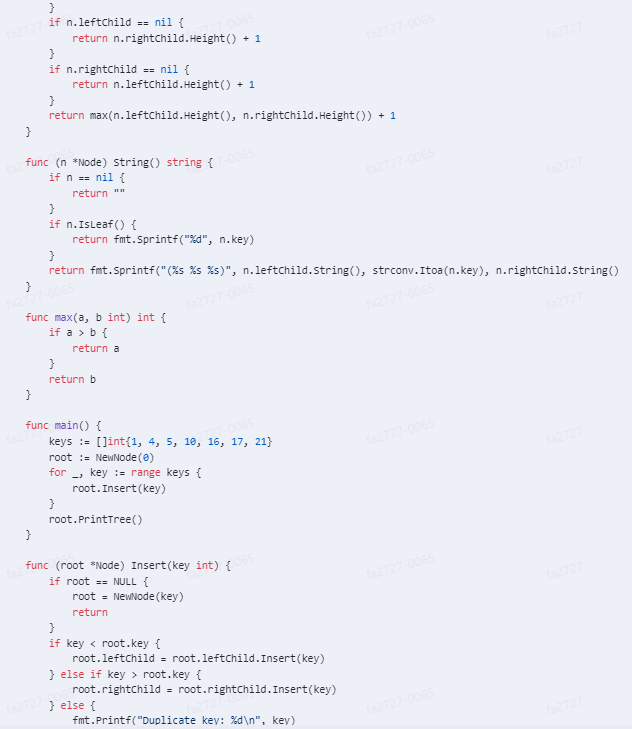
在这里插入图片描述

在这里插入图片描述
灵小智,代码正常运行:
好的,我可以帮你用Go语言画出指定高度的二叉搜索树。下面是使用递归方式实现的代码示例:package main
import (
"fmt"
)
type Node struct {
Value int
Left *Node
Right *Node
}
func main() {
keywords := []int{1, 4, 5, 10, 16, 17, 21}
heights := []int{2, 3, 4, 5, 6}
for _, height := range heights {
root := constructBST(keywords, 0, len(keywords)-1, height)
fmt.Printf("Height: %d\n", height)
printTree(root, 0)
fmt.Println()
}
}
func constructBST(keywords []int, start, end, height int) *Node {
if start > end || height == 0 {
return nil
}
mid := (start + end) / 2
root := &Node{Value: keywords[mid]}
leftHeight := height - 1
rightHeight := height - 1
if mid-start >= end-mid {
leftHeight++
} else {
rightHeight++
}
root.Left = constructBST(keywords, start, mid-1, leftHeight)
root.Right = constructBST(keywords, mid+1, end, rightHeight)
return root
}
func printTree(node *Node, level int) {
if node == nil {
return
}
printTree(node.Right, level+1)
for i := 0; i < level; i++ {
fmt.Printf("\t")
}
fmt.Println(node.Value)
printTree(node.Left, level+1)
}这段代码可以根据给定的关键字集合和高度构造相应的二叉搜索树,并打印出来。你可以根据需要修改关键字集合和高度来生成不同的树形结构。
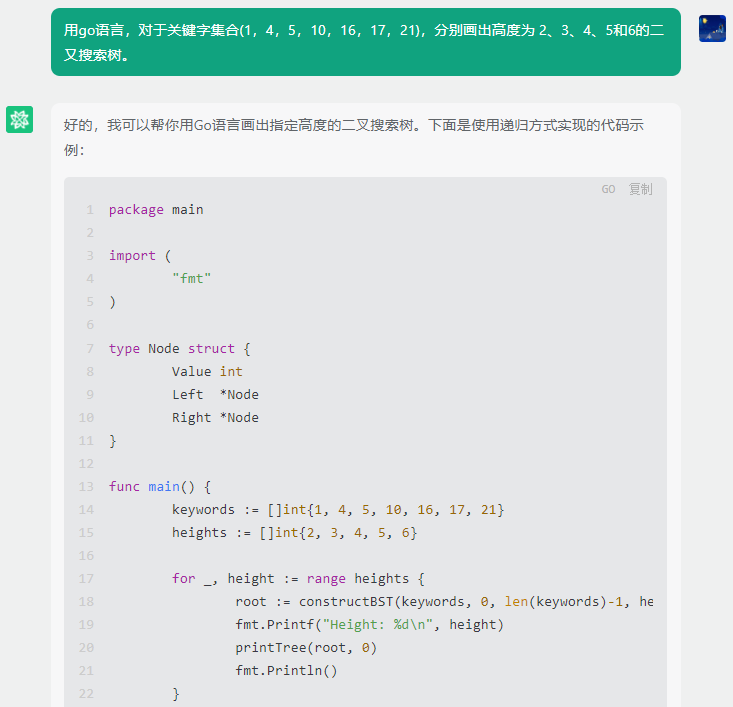
在这里插入图片描述
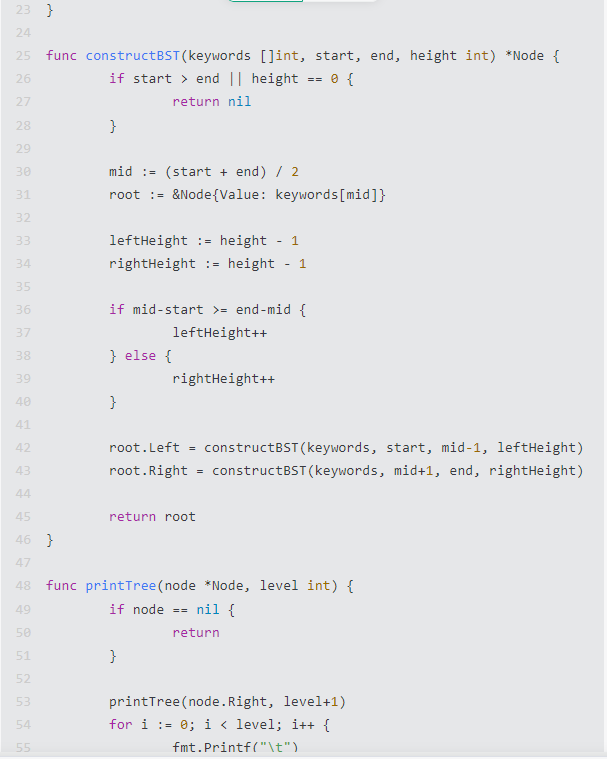
在这里插入图片描述

在这里插入图片描述
chatgpt,代码正常运行:
下面是使用Go语言实现的绘制不同高度二叉搜索树的示例代码:
package main
import (
"fmt"
"strings"
)
type Node struct {
Value int
Left *Node
Right *Node
}
func NewNode(value int) *Node {
return &Node{
Value: value,
}
}
func Insert(root *Node, value int) *Node {
if root == nil {
return NewNode(value)
}
if value < root.Value {
root.Left = Insert(root.Left, value)
} else if value > root.Value {
root.Right = Insert(root.Right, value)
}
return root
}
func PrintTree(root *Node, space int) {
const spaceCount = 4
if root == nil {
return
}
space += spaceCount
PrintTree(root.Right, space)
fmt.Println(strings.Repeat(" ", space-spaceCount), root.Value)
PrintTree(root.Left, space)
}
func main() {
keywords := []int{1, 4, 5, 10, 16, 17, 21}
heights := []int{2, 3, 4, 5, 6}
for _, height := range heights {
var root *Node
for _, keyword := range keywords {
root = Insert(root, keyword)
if height > 0 && height != calculateHeight(root) { // 如果指定了非零高度,并且当前高度不匹配,继续插入节点直到达到目标高度
continue
}
fmt.Printf("Height: %d\n", calculateHeight(root))
PrintTree(root, 0)
fmt.Println()
}
fmt.Println("----------------------------------")
}
}
func calculateHeight(node *Node) int {
if node == nil {
return 0
}
leftHeight := calculateHeight(node.Left)
rightHeight := calculateHeight(node.Right)
if leftHeight > rightHeight {
return leftHeight + 1
} else {
return rightHeight + 1
}
}运行该代码,可以输出不同高度的二叉搜索树:
Height: 2
21
17
16
21
17
16
21
17
16
21
17
16
21
17
16
Height:3
...
在这里插入图片描述
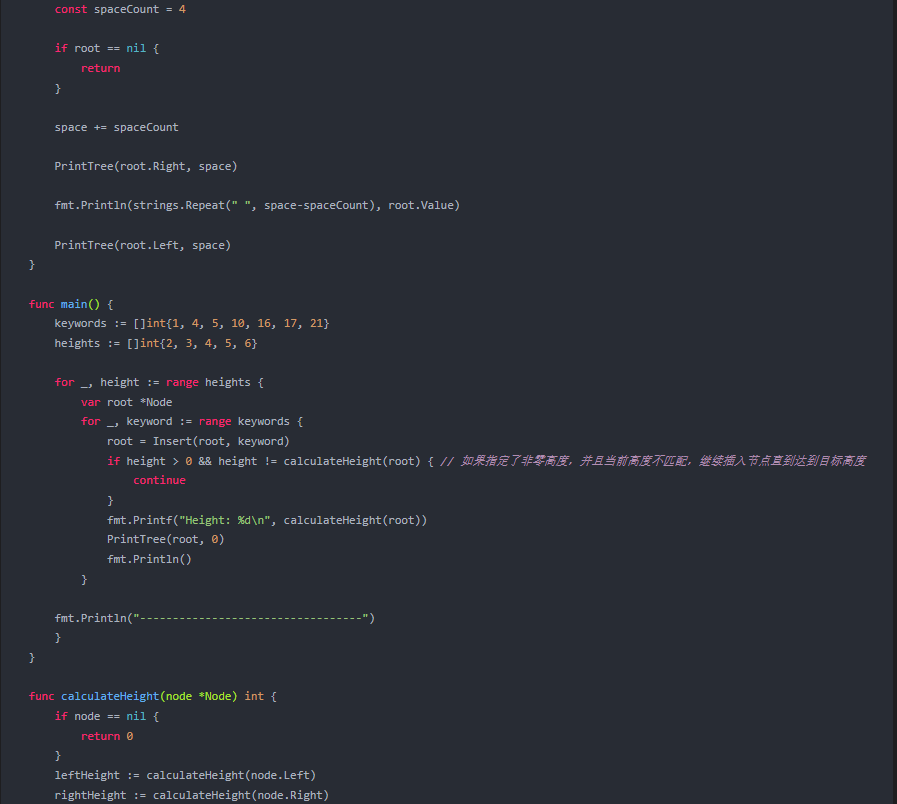
在这里插入图片描述

在这里插入图片描述